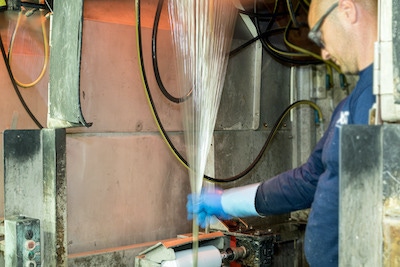Material properties of the DurethanEco range are identical to those of conventional virgin quality materials.
July 6, 2020

German materials supplier Lanxess is boosting its sustainable offerings with the debut of three polyamide (PA) 6 grades containing recycled reinforcing fibers manufactured from waste glass. Durethan ECOBKV30H2.0, ECOBKV35H2.0 and ECOBKV60XF are incorporate 30%, 35% and 60% by weight, respectively, of waste glass fibers.
|
Waste glass melts at lower temperatures than the raw materials used in manufacturing glass fibers. It therefore makes it possible to save energy and thus lower CO2 emissions. Image courtesy of Lanxess. |
Ecocycle, an independent inspection company, has examined the amount of recycled material in each compound and the long-term use of the glass waste stream using the mass balance method and awarded an ecoloop certificate in accordance with ISO 14021:2016. The glass comes from waste left over from glass fiber production (post-industrial recycling).
The mass balance approach is derived from an initiative launched by the non-profit Ellen MacArthur Foundation and is employed by companies around the world, including a number of plastic producers, for chemical recycling of post-industrial and post-consumer waste. With this process, recycled raw materials are incorporated into production together with the petrochemical or mineral feedstocks commonly used otherwise and then arithmetically allocated to the end product.
The basic principle is similar to the way in which environmentally friendly electricity or gas is fed into the electricity grid or gas network. The amount of sustainably produced energy in the electricity grid rises with demand, although it is not possible to make any physical distinction between the sources of energy at single-household level.
One point in the mass balance method’s favor is that the characteristics of the finished product – such as a PA compound reinforced with recycled waste glass fibers – are identical to those of virgin quality material. In other words, using the method does not mean sacrificing any product characteristics. “That means that an injection molder can process the compound using existing facilities just like the conventional product – and enjoy the sustainability benefits of the certified product at the same time,” says Dr. Guenter Margraf, global product manager at the company’s High Performance Materials (HPM) business unit.
HPM’s primary target for the three new compounds is the automotive industry. As Margraf explains, “For instance, Durethan ECOBKV60XF offers exceptional strength and rigidity, which makes it suitable for manufacturing structural components such as front ends, pedal bearing brackets and A-, B- and C-pillars, as well as lightweight battery trays for electric vehicles.”
HPM is going to be gradually increasing the number of ECO product types certified in accordance with the mass balance method. For example, it is planning to launch a new PA 6 with a glass fiber content of 30 percent and a reduced carbon footprint. The caprolactam required to produce this more environmentally friendly PA 6 is based on a selection of petrochemical raw materials which support this concern.
HPM is not currently using waste glass fibers from end-of-life components (known as post-consumer recycling), but does view them as a particularly sustainable raw material for use in manufacturing new glass fibers. After all, they do offer similar benefits as the domestic collection and recycling of glass containers, which have been practiced successfully for quite some time. Waste glass melts at lower temperatures than the raw materials used in manufacturing glass fibers. It therefore makes it possible to save energy and thus lower CO2 emissions. “Using waste glass cuts down on the use of resources as well, because it saves glass raw materials,” says Margraf. “It also means there’s no need to dispose of the waste glass.”
About the Author(s)
You May Also Like





